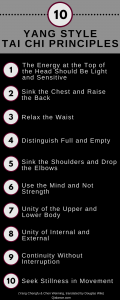What I like about Tai Chi Chuan (Taijiquan) is that even when we practice different forms and squabble over how to do them correctly, the underlying principles are the same for everyone. The 10 Tai Chi principles are the very basic principles. And they are the same for EVERYONE practicing Yang style Tai Chi.
These Yang style Tai Chi principles where transmitted orally from Yang Chengfu (楊澄甫; 1883-1936) to his student Chen Weiming (陈微明; 1881-1958). And luckily, Chen Weiming wrote down the principles and they where then published in the book “T’ai-chi ch’üan shu” (The art of T’ai-chi ch’üan; 太 極 拳 術) in 1925.
During the next months I want to study these essentials of Tai Chi. (And of course, I will share my insights with you!) To start, I put together the Yang Chengfu Tai Chi principles in Chinese and I added various translations. Because even though the principles are really simple, the translations vary slightly. And I think that is interesting, to see the different angles and emphasizes. Even without any further explanation and comments on what the principles mean, that will hopefully help you to grasp the essence of the principles of Tai Chi.
So for each principle you will see:
中文 (the Chinese characters)
- Pinyin
- Translation by Douglas Wile as in T’ai Chi touchstones: Yang Family Secret Transmissions
- Translation by Louis Swaim as in Mastering Yang Style Taijiquan
- Translation by Jerry Karin from the Yang Family Homepage: Ten Essentials of Tai Chi Chuan
Now let’s start my principles series with the list of the 10 essentials of Tai Chi Chuan:
10 Yang style Tai Chi principles
- 虛靈頂勁
- Xu ling Ding Jin
- The Energy at the Top of the Head Should Be Light and Sensitive
- An intangible and lively energy lifts the crown of the head
- Empty, Lively, Pushing Up and Energetic
- 含胸拔背
- Han Xiong Ba Bei
- Sink the Chest and Raise the Back
- Contain the chest and raise the back
- Hold in the Chest and Slightly Round the Back
- 鬆腰
- Song Yao
- Relax the Waist
- Relax the waist
- Relax the Waist
- 分虛實
- Fen Xu Shi
- Distinguish Full and Empty
- Distinguish insubstantial and substantial
- Separate Empty and Full
- 沈肩墜肘
- Chen Lian Zhu Zhou
- Sink the Shoulders and Drop the Elbows
- Sink the shoulders and drop the elbows
- Sink the Shoulders and Drop the Elbows
- 用意不用力
- Yong Yi Bu Yong Li
- Use the Mind and Not Strength
- Use consciousness, not strength
- Use Intent Rather than Force
- 上下相隨
- Shang Xia Xiang Sui
- Unity of the Upper and Lower Body
- Upper and lower follow one another
- Synchronize Upper and Lower Body
- 內外相合
- Nei Wai Xiang Ge
- The Unity of Internal and External
- Internal and external are united
- Match Up Inner and Outer
- 相連不斷
- Xiang Lian Bu Duan
- Continuity Without Interruption
- Linked without breakage
- Practice Continuously and Without Interruption
- 動中求靜
- Dong Zhong Qiu Jing
- Seek Stillness in Movement
- Seek stillness in motion
- Seek Quiescence within Movement

I find it actually interesting, that there are some principles where the translations varies (e.g. principle #1) and then there is #3 which everyone translates as “relax the waist”! As I said, I will have a look at each principle over the next months and I am excited to digg deeper!
For now, if you want to know more about the basic principles of Tai Chi Chuan right away, here are some additional resources with individual comments:
- You can have a look at the two books I quoted above. They both share the comments from Yang Chengfu and Chen Weiming. You can get them at your local bookstore or buy them at Amazon:
- If you are interested in the current Yang family view, read about the principles on their homepage.
- In the article, there are a couple of interesting drawings for each principle.
- Here you can find the Chinese original text (click on the small pictures on the side!)
- If you want to study even more individual comments and Tai Chi philosophy, read here or here.
- And finally, if you want to know how to PRONOUNCE the principles in Chinese, you can listen to them here.
Or you can come back and find my personal comments on each principle within the next weeks! What I want to do is to practice with one principle in mind for a couple of days and see which insights I get. Maybe you want to join me? Just choose a basic Tai Chi move or a form and try to incorporate one of the principles!
Happy Qi!
Angelika
If you are interested in Tai Chi moves and their Chinese name, have a look at The Taijiquan & Qi Gong Dictionary!
Original article and pictures take qialance.com site
Комментариев нет:
Отправить комментарий